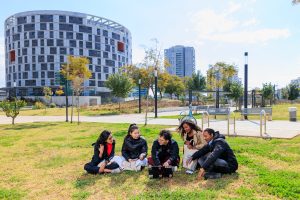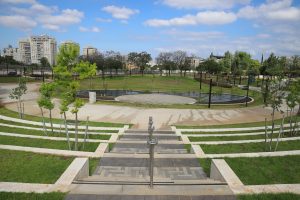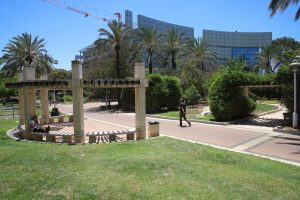Home » Programs » Full Degree Programs » Undergraduate - Fully instructed in English » BA in Linguistics
Home » Programs » Full Degree Programs » Undergraduate - Fully instructed in English » BA in Linguistics




Led by internationally recognized faculty that bring unique exposure to diverse approaches to the study of human language
At Bar-Ilan University, students learn from the world’s leading researchers in Linguistics, studying both theoretical aspects of linguistics analysis and experimental and corpus-based research methods. Linguistics at BIU provides training both in deep formal theoretical models and in applied and interdisciplinary studies related to fields such as brain science, bilingualism and language impairments.
Students gain a solid background in phonology, syntax, semantics, and pragmatics, as well as in more applied areas such as psycholinguistics and neurolinguistics. Studies take place in English, yet the BIU Linguistics degree provides students with the tools for analyzing any human language – English, Hebrew, Arabic, Russian, and many others.
Upon completion of the degree, students can explore careers not only in academia but also in teaching (including English as a second language), publishing, speech pathology, and information technology, to name but a few.
In addition, the double major with Linguistics is offered to students who would like to specialize not only in English Literature but also in Linguistics. This is an excellent opportunity for those students that would like to utilize a combined knowledge of both fields in their career or continued academic endeavors.

First year courses

This course introduces students to linguistics as a scientific study of human language. The course will focus on major subfields of linguistics: phonetics, phonology, morphology, syntax, semantics, and pragmatics. Language is a complex rule-governed mental system. We will discuss how language is different from animal communication. Students will learn to identify principles shared by all human languages and parameters along which languages differ.
The course provides an introducing the study of systems and patterns of sounds and structures in human languages. In Phonetics, we will examine the features of linguistic sounds and their categorization. In phonology, we will examine is the interaction of sounds that result in both universal and language specific processes. Students will acquire basic tools for phonetic and phonological analysis of linguistic data.
This course is an introduction to the generative approach to analyzing sentence structure. Elements of syntactic analysis are introduced: constituents and tree diagrams, arguments and modifiers, thematic roles and the theta criterion, movement and abstract syntactic representations. This course provides the tools for understanding the source of phenomena such as structural ambiguities and the formation of interrogative sentences.
An introduction to the theory and techniques of formal semantics, i.e. to a theory of meaning in natural language. This theory gives interpretation to natural language expressions in a systematic way, by using formal tools of logic and philosophy of language.
Second/third year courses

The course focuses on the process of first language acquisition across languages, explaining various phenomena (such as the acquisition of word order, inflections and subordination) from the different theoretical perspectives: developmental psycholinguistics on the one hand and the generative (nativist) theory on the other hand. The course will also give some insight to research methodologies used in this field.
The course introduces students to various methods, tools and techniques used in linguistic research. The course is designed to provide students with a basis for critical reading of scientific reports and basic skills for conducting their own research.
The course introduces concepts, methods, assumptions and findings in psycholinguistic research including language acquisition, processing, disorders, bilingualism and literacy.
Only one species, the human species, has a communicative system of the complexity of human language. In this course on Language Emergence and Evolution, we explore various different approaches to language evolution by considering the communication systems that unfold in: (1) pidgin communication, (2) child language, (3) language of trained apes, (4) young emerging sign languages, (5) iterative learning experiments, and (6) computational models of language simulation.
Languages exhibit variation which is systematically constrained by a number of social factors. In this course on Sociolinguistics we discuss 1) the different approaches to sociolinguistic investigation, 2) the classic sociolinguistic theories and findings, and 3) the most important driving forces behind language variation and change.
BA-level elective which is a continuation of 287. This course introduces more advanced topics that form the foundations of modern syntactic theory: functional projections and recent versions of X-bar theory, clause structure and the syntactic representation of argument structure, movement operations and cross-linguistic variations in word order, case, agreement, and binding. Abstract notions such as empty categories (PRO, trace) and non-overt structural representations are developed, with the goal of arriving at a systematic theory of syntax that can not only describe the language but also explain why it has the observed properties.
This course introduces tools for capturing compositional interpretation of natural language expressions, so their meaning is systematically derived from the meaning of their syntactic parts and the way they are composed. This is done by introducing the theory of types the lambda calculus for capturing in a precise and a formal way function-argument relations in the syntactic tree. We apply the system to sentences with sentential operators, gradable adjectives, quantifiers and presupposition triggers, and gain interesting insights on puzzles and challenges regarding natural language interpretation.
An introduction to concepts in semantics and pragmatics, including model theory, quantification, definiteness, tense, event semantics. The course presupposes an introductory course in basic semantics, and uses minimal formal techniques beyond basic quantification theory.
Seminars

The course discusses reading development in children with developmental disorders including dyslexia, developmental language disability (or SLI), ADHD and Autism. The focus is on the interplay between linguistic processing skills and reading development in these populations.
This seminar deals with work in theoretical syntax which is based not only on the methodology of using informal grammaticality judgments but also on quantitative research methods, and in particular experimental syntax and corpus studies. Through discussions of specific studies we also deal with deeper theoretical questions regarding the nature of abstract syntactic representations and the extent to which different syntactic models are suitable representations of the full range of observed facts.
The course focuses on clinical aspects of psycholinguistics with an emphasis on speech perception, mental lexicon, language acquisition and language impairments discussing both theoretical and empirical issues from different theoretical perspectives: developmental psycholinguistics, the generative (nativist) theory and the usage-based approach. The course explores methodological issues related to experimental design and statistical analysis of findings in order to prepare graduate students for carrying out experiments in psycholinguistics and writing research papers.
This research seminar focuses on language acquisition by children diagnosed for Developmental Language Disorder (DLD), with special emphasis on monolingual verses bi-lingual development in this population, providing the students with hands-on experience in psycholinguistic research, discussing empirical findings from theoretical perspective. The course exposes the students to aspects of lexical development including early words and fast mapping, the acquisition of inflectional and derivational morphology and morphological awareness, the role of memory and other cognitive skills in lexical development, grammatical information in the lexicon, and the contribution of lexical knowledge to narrative abilities.
In this seminar, we discuss different types of acquired language and reading impairments, and review current findings in light of different models of language processing in the brain. We further examine the use of advanced imaging methods, such as structural and functional MRI, in the study of brain reorganization following brain damage. The goals are to deepen our understanding of healthy language organization by identifying selective patterns of language impairments, to discuss patterns of compensation and recovery, and present current research on effective treatment methods.
A quick and intensive introduction to syntax and formal semantics in generative linguistics, and to the analytical skills it requires. The syntax part studies representation of sentence structure using tree diagrams, constituency tests, X-bar theory, forming yes-no and WH questions by movement, etc. The semantics part studies the benefits and limitations of formal languages (like predicate calculus) as tools to capture interpretation of various operators and quantifiers in natural language, entailments and presuppositions, the semantics-pragmatics interface, etc.
The seminar studies the contribution of the particles only and even in English and of their correlates in other languages (Hebrew, Arabic, Russian, Chinese, etc.). Such particles were intuitively described in the past as making opposite or ‘mirror image” semantic / pragmatic contribution, regarding notions about additivity and scalar ordering. We examine to what extent this ‘mirror image’ intuition is correct and how to formally and precisely capture it.
Autism Spectrum Disorders (ASD) is a heterogeneous neurodevelopmental disorder characterized by difficulties in social communication and repetitive behavior/ interest. In this seminar we will explore linguistic characteristics of individuals with ASD. We will discuss how atypical language and cognitive development contribute to linguistic theory.
The investigation of signed languages is crucial for understanding the properties of language in general. In this seminar on the Linguistics of sign languages, we explore the essential aspects of sign linguistic structure: phonology, morphology, word order and prosody, as well as how they differ or relate to the structure of spoken languages.
Issues in noun phrase semantics, including definiteness, count/mass, genitive constructions, generalized quantifiers.
The seminar examines the phenomenon of language contact and borrowing elements form one language to another. It examines the strategies that speakers take in the adaptation of loan items (and lack thereof). This provides direct access to the morphological and phonological processes that are active in the grammar and provides insights on the mechanism of languages and how different types of criteria are taken into consideration.
International School
Bar-Ilan University
Ramat-Gan, Israel 5290002
Tel: +972- 3-738-4245
Email for further information
[email protected]

Leave your details and we’ll get back to you soon
Explore a range of undergraduate degrees in English, including Political Science, Communication, and Humanities. We also offer 16 diverse graduate programs and a brand-new Cyber Security & Data Protection certificate – all in English!

If you find an error in content or missing information – please update us. In any case, the binding information appears on the website of the Council for Higher Education.
We firmly believe that the internet should be available and accessible to anyone, and are committed to providing a website that is accessible to the widest possible audience, regardless of circumstance and ability.
To fulfill this, we aim to adhere as strictly as possible to the World Wide Web Consortium’s (W3C) Web Content Accessibility Guidelines 2.1 (WCAG 2.1) at the AA level. These guidelines explain how to make web content accessible to people with a wide array of disabilities. Complying with those guidelines helps us ensure that the website is accessible to all people: blind people, people with motor impairments, visual impairment, cognitive disabilities, and more.
This website utilizes various technologies that are meant to make it as accessible as possible at all times. We utilize an accessibility interface that allows persons with specific disabilities to adjust the website’s UI (user interface) and design it to their personal needs.
Additionally, the website utilizes an AI-based application that runs in the background and optimizes its accessibility level constantly. This application remediates the website’s HTML, adapts Its functionality and behavior for screen-readers used by the blind users, and for keyboard functions used by individuals with motor impairments.
If you’ve found a malfunction or have ideas for improvement, we’ll be happy to hear from you. You can reach out to the website’s operators by using the following email
Our website implements the ARIA attributes (Accessible Rich Internet Applications) technique, alongside various different behavioral changes, to ensure blind users visiting with screen-readers are able to read, comprehend, and enjoy the website’s functions. As soon as a user with a screen-reader enters your site, they immediately receive a prompt to enter the Screen-Reader Profile so they can browse and operate your site effectively. Here’s how our website covers some of the most important screen-reader requirements, alongside console screenshots of code examples:
Screen-reader optimization: we run a background process that learns the website’s components from top to bottom, to ensure ongoing compliance even when updating the website. In this process, we provide screen-readers with meaningful data using the ARIA set of attributes. For example, we provide accurate form labels; descriptions for actionable icons (social media icons, search icons, cart icons, etc.); validation guidance for form inputs; element roles such as buttons, menus, modal dialogues (popups), and others. Additionally, the background process scans all of the website’s images and provides an accurate and meaningful image-object-recognition-based description as an ALT (alternate text) tag for images that are not described. It will also extract texts that are embedded within the image, using an OCR (optical character recognition) technology. To turn on screen-reader adjustments at any time, users need only to press the Alt+1 keyboard combination. Screen-reader users also get automatic announcements to turn the Screen-reader mode on as soon as they enter the website.
These adjustments are compatible with all popular screen readers, including JAWS and NVDA.
Keyboard navigation optimization: The background process also adjusts the website’s HTML, and adds various behaviors using JavaScript code to make the website operable by the keyboard. This includes the ability to navigate the website using the Tab and Shift+Tab keys, operate dropdowns with the arrow keys, close them with Esc, trigger buttons and links using the Enter key, navigate between radio and checkbox elements using the arrow keys, and fill them in with the Spacebar or Enter key.Additionally, keyboard users will find quick-navigation and content-skip menus, available at any time by clicking Alt+1, or as the first elements of the site while navigating with the keyboard. The background process also handles triggered popups by moving the keyboard focus towards them as soon as they appear, and not allow the focus drift outside of it.
Users can also use shortcuts such as “M” (menus), “H” (headings), “F” (forms), “B” (buttons), and “G” (graphics) to jump to specific elements.
We aim to support the widest array of browsers and assistive technologies as possible, so our users can choose the best fitting tools for them, with as few limitations as possible. Therefore, we have worked very hard to be able to support all major systems that comprise over 95% of the user market share including Google Chrome, Mozilla Firefox, Apple Safari, Opera and Microsoft Edge, JAWS and NVDA (screen readers), both for Windows and for MAC users.
Despite our very best efforts to allow anybody to adjust the website to their needs, there may still be pages or sections that are not fully accessible, are in the process of becoming accessible, or are lacking an adequate technological solution to make them accessible. Still, we are continually improving our accessibility, adding, updating and improving its options and features, and developing and adopting new technologies. All this is meant to reach the optimal level of accessibility, following technological advancements. For any assistance, please reach out to